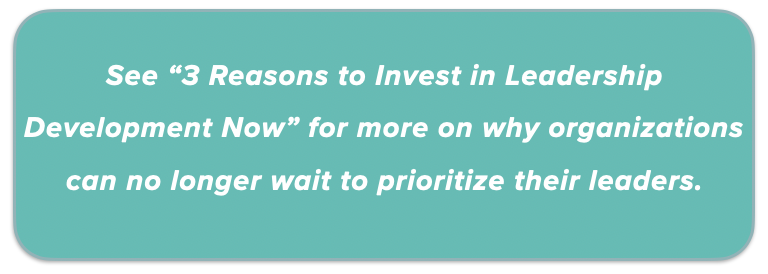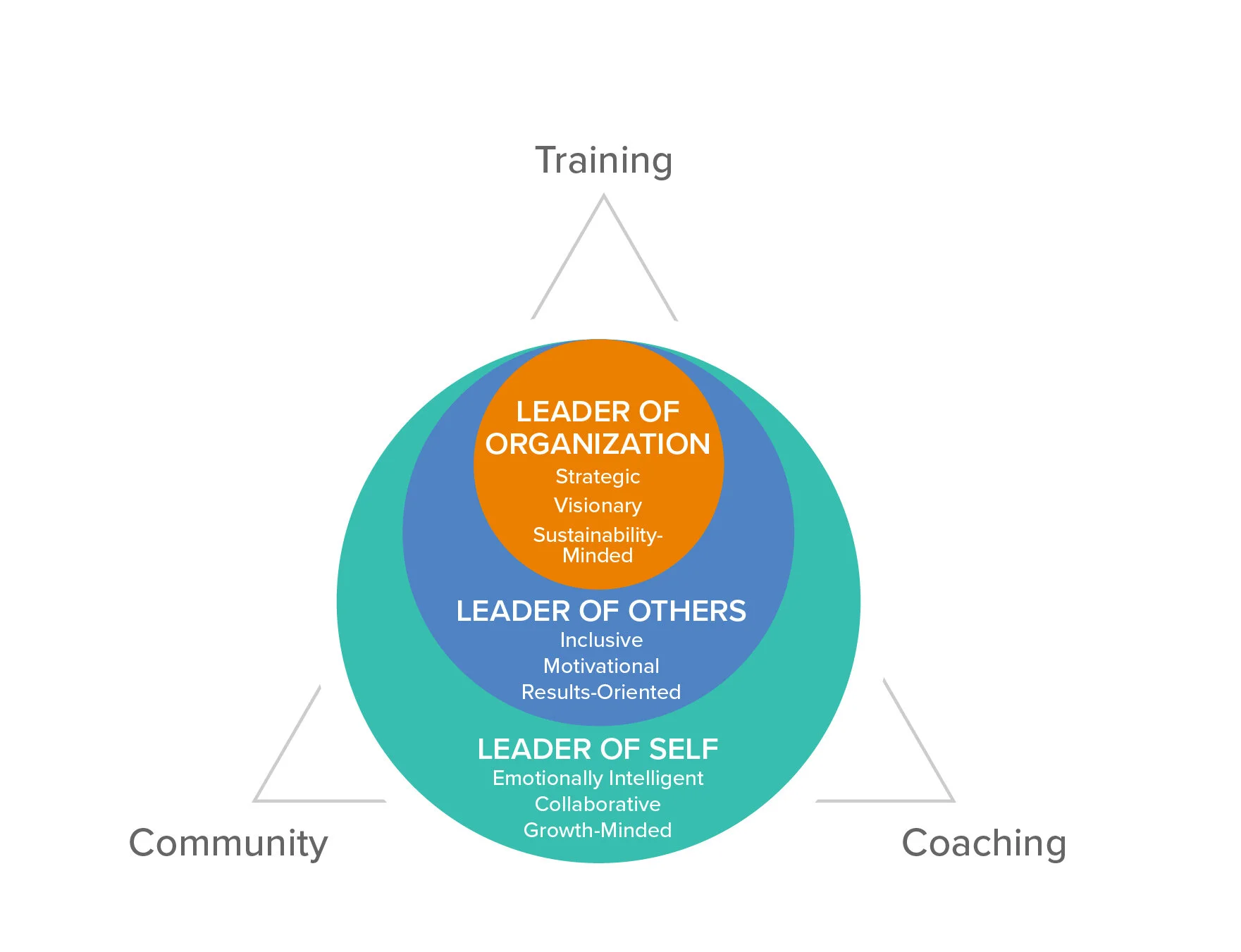A New Kind of Leader for a Rapidly Changing World
Companies are counting on their leaders to navigate through a daunting cluster of never-before-seen challenges. And leaders are counting on their organizations to support them along the way — and into the future of work. What kind of leader will succeed? And what kind of learning and development programs will those leaders need to make this crucial transition?
“My people have never led through anything like this. In fact, neither have I.”
We hear this refrain almost daily in the management consulting and leadership development work we do at sr4 Partners. Seasoned C-suite leaders say it. Savvy people operations and HR professionals say it. Departmental directors in the prime years of their career say it.
Full disclosure: We say it, too. It’s simply the truth. We’re all coming to grips with the realization that the so-called “new normal” in the workplace is a lot more new than it is normal — the result of massive, sudden, and simultaneous shifts spurred by COVID-19 and the accompanying surge in remote work, the racial reckoning causing companies to revisit their policies and practices, and the onset of an economic downturn whose size and scope is unlike any in recent memory.
Denise Bindleglass is the Head of People for ActiveCampaign, one of the fastest growing tech companies in Chicago. She explains, “Before COVID, we’d been responding to the pressure to attract and retain top talent for some time. And our investments in technology, as well as in creating a more equitable and inclusive culture, have been priorities for years. But 2020 has created even greater urgency in these areas. I think every organization is feeling the weight of this moment.”
For ActiveCampaign and other forward-looking organizations, this increased sense of urgency also brings a renewed focus on the vital role of leaders. How else, if not with fully equipped and supported leaders at the helm, will companies push beyond the goal of sheer survival and find their way toward what business guru Seth Godin calls “transformative success”?
Develop your leaders’ competence and character
It’s one thing to identify the importance of developing a new kind of leader for our changing world. It’s another to identify what, exactly, that new kind of leadership might involve.
In our work over the past 10 years, we’ve helped a wide range of organizations — Fortune 100 companies, high-growth startups, and nonprofits — explore the concept of “holistic leadership.” Holistic leaders come to work ready to tap into a deep reservoir of both competence and character as they advance human and organizational potential to have a positive impact in society.
As Rich Johnson, an sr4 Principal with more than 25 years of experience helping leaders excel, explains, “Leaders approach a situation or decision in terms of both what they’re going to do and how they’re going to do it. The ‘what’ requires competence in certain skills like delegation, communication and strategic thinking. The ‘how’ requires character.”
For example, in an early management role that he held in his twenties, Rich found himself leading a group of people who were significantly older than he was. He’d learned that inviting feedback about his leadership from his team was considered a best practice — a skill to employ in his one-on-ones.
An experienced woman on his team came fully prepared with a list of things for him to work on. The most pressing item was her observation that Rich sometimes became so focused on the team’s end goals than the team felt like they were just “being used.”
“Those were her exact words,” he says. “It was like a punch in the gut. She said that there were times when team members were struggling with the work, or maybe even something personal, but I was in my own world, plowing forward with little regard for their needs. And the thing was, she was right. I decided to change.”
Viewed through the lens of holistic leadership, inviting feedback is a matter of competence — something technical to follow through on as a manager. But listening and having empathy for how your actions affect your team is a character-driven choice.
A note of caution: We’ve seen some organizations fall into the trap of focusing solely on building competence. Character-driven traits like humility and self-awareness may seem unlearnable at first glance — qualities that people are born with or develop early in life. But we advise clients to question that assumption. We’ve seen, time and again, that character absolutely can be cultivated. And companies can’t afford not to cultivate it in their people, because it’s only when you put competence and character together that the potential for leaders’ impact is enormous.
Enormous impact is likely what it will take to meet the demands of the transformation ahead, allowing you to create a workplace where:
Your employees feel more energized and committed; you don’t have to worry that they’re just biding their time until the economy improves and they can jump ship.
Your business is taking smart risks and breaking new ground instead of living quarter-to-quarter; you’re not just surviving, you’re thriving.
Your organization is connected to the vibrant day-to-day of the communities around you, engaging in a healthy, two-way exchange that fuels broader economic health and innovation — and helps protect your organization from becoming stale and siloed.
The path to holistic leadership requires ongoing learning and development
Holistic leadership doesn’t happen by chance, or just because a leader is talented. There’s a strong foundation underlying their performance, one that they’re continuously building on and tweaking over the course of their careers. Just as jazz players gradually internalize fundamentals like key signatures, tempos, and chord progressions in order to become adept improvisers — and then keep practicing and applying tips from top musicians over their lifetimes — effective leaders need ongoing support to realize their true potential and take their organizations to new heights.
This need for ongoing support is critical to keep in mind as you revisit your organization’s infrastructure for leaders’ learning and development (L&D). The days of sending leaders to the occasional, one-size-fits-all training filled with lectures and a litany of PowerPoint slides are over. It just doesn’t work. What’s more, the people your organization needs most right now simply won’t tolerate that kind of check-the-box learning.
You have better options for developing your people. We recommend that you start with these three objectives:
1. Include leaders at all levels — and offer a range of solutions to reflect their different needs.
Top-down hierarchies aren’t well-suited to today’s rapid pace of change. And leaders at all stages of the journey — from individual contributors who lead others through informal influence, to early- and mid-level leaders managing their first or second team, to executives making high-level strategic decisions — affect business outcomes and contribute to organizational culture.
Given these leaders’ varying needs, a static curriculum won’t adequately prepare your people to lead with competence and character. Instead, consider offering a combination of virtual instructor-led training, community-oriented peer learning and connection, and individual coaching. What might that look like in practice?
Zoro is an online industrial supplier and a subsidiary of the Fortune 100 legacy company Grainger. With 500 employees and a more entrepreneurial culture than its parent, Zoro has spent the past two years prioritizing leadership development at all levels. As a result, they’ve seen increased retention, higher productivity, and improved employee engagement. They hold monthly trainings through sr4's Elevate program, where first-time people leaders—from managers to executives—learn about bias and belonging, role-play healthy conflict, and explore other skills central to people leadership. Meanwhile, through Zoro’s corporate membership in the Holistic Leadership by sr4 Leadership Community, employees at all levels can connect with leaders from other organizations to discuss and learn about relevant skills, mindsets, and attributes. And for leaders looking to advance or increase their responsibility, Zoro encourages and supports one-on-one coaching.
This type of multi-faceted approach will help you engage with your leaders — all of them — at every stage of their journey. They’ll grow with the organization, and the organization will grow with them.
2. Prioritize and nurture peer communities.
People learn as much, if not more, from their peers — those going through similar situations and tackling similar problems — as they do from experts. Those peers may be in the same or different organizations, the same or different industries. They can swap stories. Open up about mistakes. Share tips and advice grounded in lived experiences.
“Peer-to-peer exchanges make it safe for leaders to be vulnerable rather than right, to listen rather than fix, and to feel the discomfort of ambiguity rather than avoiding it.”
Peer learning also provides the motivation to keep growing and striving, no matter where you are in your career. As Ryan Jeffery, Principal and Head of Growth at sr4 Partners, says, “The leadership journey is so much more meaningful when you have a community of people who care about one another and are committed to leading with both competence and character.”
Ryan sees this dynamic play out week after week in sr4 Partners’ Holistic Leadership Community, which features year-round interactive trainings and discussions for leaders at all levels, representing a wide range of sectors. Participants might help one another build self-awareness by sharing a word or phrase that captures how they’re feeling about recent economic or political events, or offer feedback on their collaboration and listening skills by talking through a recent communication breakdown that they could have handled differently.
These peer-to-peer exchanges, he notes, make it safe for leaders — who are typically under tremendous pressure to have all of the answers — to be vulnerable rather than right, to listen rather than fix, and to feel the discomfort of ambiguity rather than avoiding it.
This is a vital part of developing character. In Dare to Lead, Brené Brown writes, “The courage to be vulnerable is not about winning or losing. It’s about the courage to show up when you can’t predict or control the outcome.” A community of peers illuminates and normalizes this kind of vulnerability as a source of strength for leaders.
3. Provide experiential learning opportunities.
Which L&D initiative do you think is more likely to inspire diversity-minded hiring: a one-off training on how diversity improves business results, or an experience in which hiring managers meet skilled immigrants and refugees, and then exchange stories about the hiring and job-search processes?
While both can be valuable, the power of the second approach — an example of experiential learning from sr4 Partners’ playbook — isn’t something that people are likely to forget. “Teaching concepts has its place,” says sr4’s Head of Community Kesia King. “But there’s nothing like an experience that widens your perspective and helps you formulate your own insights.”
It’s also possible to weave experiential learning into online L&D solutions. One tactic that sr4 finds highly effective is to begin online sessions by using the breakout function of your online platform. Pair up participants and prompt them to share a story. For example, instead of asking, “What are your expectations for today?” you might try “Who has been one of the greatest cheerleaders in your life? What did they do, and how did they make you feel?”
“When people share stories and tap into the emotional side of who they are, I find that they’re much more likely to receive teachings and insights, as well as apply them in a practical and relevant way,” Kesia explains.
These three objectives aren’t easy to implement. But leadership isn’t easy, either, and its value to your organization cannot be understated — especially in today’s challenging business environment.
At sr4 Partners, we help organizations lead. For over a decade, our work has helped organizations cultivate healthy leaders, cohesive teams, thriving cultures, and inclusive change. We do this through our consulting services, our Holistic Leadership Community, and our Elevate Leadership Series.








